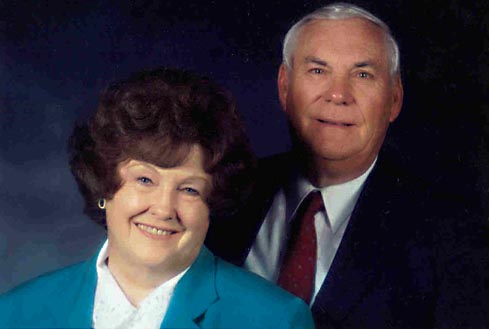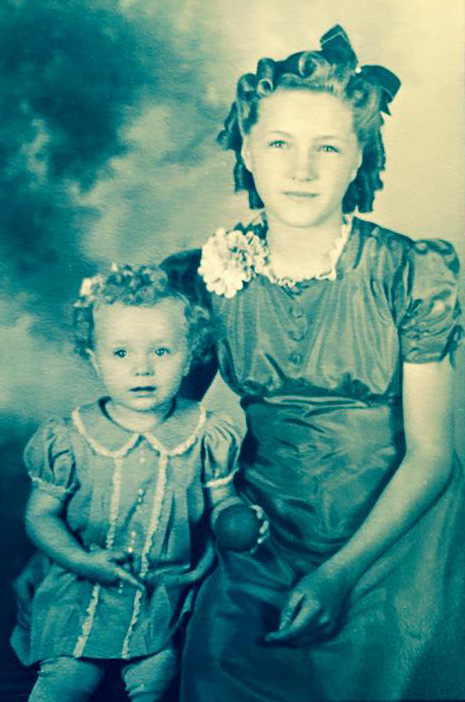
Mission to Michigan . . .
I have a small cache of church talks given by Mom and
Dad about their mission to
The following are snippets gleaned from that ‘cache’ . . . I think you might find them interesting if not inspiring.

MTC blues . . .
“The MTC as you know can be pretty exhausting and all that stuff, but you can do it, things will settle down when you get to your mission and you will have some great experiences. If it’s any comfort to you when we got to the mission office and I found out all the things we had to do and the hours involved, I told my trainer I’d go home but I didn’t want to disappoint my children and grandchildren. He laughed and said tell them to get used to disappointment and he’d go with me. I was only kidding, but the thought crossed my mind.”
Grandpa Cloward's legacy . . .
“We spent the first 14 months of our mission
working in the Mission office in
I was blessed to grow up in a small community with parents, grandparents, great -grandparents and cousins close by. The activities of the whole town were based on the standards and programs of the church. Dances, plays, programs, weddings, even funerals. From these people I learned about the love of the Lord and the love of others. The gospel drew us all closer together. I am grateful for these people and for my heritage.
My grandfather was called to serve a mission in 1913.
He left behind his wife and my mother who was 14 months old.
Most of his work was done in the
Our mission sounds somewhat easier, even though our age has brought wrinkles and rigidity; there is still life after 70.
Elder Russell Ballard said, at a funeral sermon, “Life isn’t over for a Latter-Day-Saint until he or she is safely dead, with their testimony still burning brightly. And
I remember David B. Haight saying, he often thought of the vast number of retired people sitting in rocking chairs or sunny patios when they still have many years of productivity in them . . . Rocking chairs and sunny patios sound pretty good, but we know we are being blessed as we go about our work each day and are grateful for that blessing in our lives.”
In Ludington . . .
“Our situation has changed so that we can, at last, write letters home. Until now, we could just work, eat and sleep.
Three weeks ago, the president called us in to
ask if we would accept a different assignment. It seems that office couples are
in short supply and this mission is going to try to have only one such couple
and 2 missionaries in the mission office.
It seemed only logical that we could accept another position, and are we
happy! 60 hours per week staring at
the “one eyed monster” was affecting our health. However during that time,
Rowena passed on to the missionaries thousands of referrals. Sometimes as many
as 70 per day (she has to contact each companionship with referrals in their
area each day, there are 88 companionships in our mission), She also processed
more than 400 baptisms in the nine months of 2000 she was there.
I of course spent money like mad, over a million in the time I was in the
office (Note:
Dad was in charge of finances for the mission)
Our new assignment is in the form of “fellowshipping” at the Ludington branch which has 100 members but only about 50 are active. We are to do all that we can to activate these members (there are only 6 Melchizedek Priesthood holders and no Aaronic Priesthood in the branch). Even the Branch President is from a ward in a different town.(Hart, about 30 miles away). We can work to our own schedule and even take naps in the afternoon and walk along the shore in the evening, oh joy; it is it beautiful, and does not have the dank smell of the ocean.
Ludington is about 175 miles north and west of
We are comfortable in the branch and have been
received with open arms. The chapel
is an old but renovated
What do missionaries do?
“The common view of missionaries:
2 elders or 2 sisters walking along the sidewalk and knocking on doors
Reality is:
Much more……
attending meetings: sacrament, correlation, ward council, speaking, bearing testimonies, greeting at door, bringing members and investigators to services (Some live 30 or so miles away), teaching classes, taking members to rest homes, hospitals, nursing homes, fellowshipping members and non members alike, working at hospitals, nursing homes, rest homes, Red Cross work and performing community service, cutting grass, raking leaves, pulling weeds, erecting fences, painting fences, painting houses both inside and out, putting on new roofs, repairing roofs, baking corn bread, blueberry muffins, brownies, rice crispy squares, and popcorn balls for members and non members, attending weddings, baptisms, funerals, helping members and non members move and cleaning up after the move, being ‘grandpas and grandmas’ to the missionaries, feeding the missionaries, freeing-up the younger missionaries to find contacts, performing mission office duties, and strengthening the wards and branches.”
Whew! .
. . . . I’m tired just reading all
that. ;-)
What Mom did in the office . . .
“I’m also going to tell you about my mission. I served as recording and referral secretary in the Mission Office for 14 months. Most of my hours were spent at the computer, about 10 hours per day including Saturday. The thing I enjoyed most was taking care of all the baptisms. The most challenging ones were the Spanish baptismal records, but I learned a little about Spanish and we had some choice Spanish Elders.
Working in the office was also a great blessing, because I had such close contact with all the missionaries. I talked by phone with many of them each day. They came into the office very often – I suspect sometimes because of the goodies we provided. I knew by name and face more than 200 of the finest young men and women in the Church today. Being able to work so closely with them, they became like our grandchildren away from home.”
Note: I remember this . . . the phone call . . . the hurried trip to Salt Lake . . . the worry . . . and the miracle
“On the night of November 13, 1971, the
telephone by our bed rang and my father told me to hurry to
She was a victim of a car-train collision that crumpled and destroyed her car and left her all but dead, face down in two feet of water in a canal. She had been thrown from the car into a concrete abutment and dropped into the water. Of the 20 accidents there, until barriers were installed, she was the only survivor.
After the crash, little was left of her car, but the car behind her was occupied by a registered nurse who, along with another man pulled her from the water and started her breathing.
The only thing functioning was her heart. Her skull was crushed at the back. Her neck was broken. Her chest crushed. Her pelvis was broken and the femur in her left leg was broken. Not a single part of her was untouched except her face -- the only part without severe lacerations. She stopped breathing several times on the way to the hospital where a new breathing machine kept her alive.
I remember them coming out to talk to us and saying it was impossible, she couldn’t survive even a few hours. Then as she was placed in the intensive care unit they said she couldn’t make it for 24 hours. We just stayed there praying.
She did live—over a month and a half in a deep coma. We would go in and talk to her every day hoping she would know we were there. This was a great opportunity to see all the programs of the church in action. The bishop called the ward together at the church. Myrna was in the relief society presidency and they fasted and prayed for her as a ward. The home teachers were there almost every day. Members of the ward came to check on her constantly. Food was provided for my parents and her children & husband for several months. The bishopric came every day. When her condition would become worse, we occasionally called the bishop, but generally the bishopric would be driving in different parts of the city and get the impression they were needed at the hospital and there they’d be. I got to know the bishop so well he was like a member of the family. She received many blessings from them. Many times procedures the doctors had outlined didn’t need to be done. Many scheduled surgeries and operations were unnecessary. A few doctors joined in the prayers and told us they would do nothing until it was proved necessary because even x-rays seemed to change with the blessings.
The stake president called Thomas S. Monson and asked if he would come to the hospital and give her a blessing. I remember that day so well. As he shook my hand I knew everything was going to be all right. Just as he arrived, so did the bishopric, all from different parts of the city—all the priesthood holders went into the intensive care unit to assist in the blessing—all came out with tears streaming down their faces. He promised her that she would live and be healed.
Time dragged by. A few days later Apostle Monson called to check on her progress. When told that she seemed just the same he said, “I am going to speak at a conference, I will pray for her there, and then he said the first presidency and the twelve apostles would pray for her in the upper room of the temple.
The accident occurred November 13th; she awakened December 26th.
Once awake, the doctors feared she might never walk, talk or be the normal person she once was.
She was faced with having to learn again how to be that person.
She was told she would be in the hospital another 6 months and then in a rest home before she could go to her own home. She was discharged January 15th – in less than a month—in a cast from the chest down and a brace between her legs.
It was necessary for her to learn to read, write and spell all over from beginner books. When the cast was removed she was unable to walk and much therapy was needed. Speech problems persisted, the words would not come out as sound and she feared brain damage. But a little surgery on her voice box remedied that.
There are no visible signs to people who know nothing about the accident. She has a few scars on her neck where the 'trach' and instruments were inserted, a faint scar above her nose, and one leg is about an inch and a half shorter than the other. She has her shoe built up and has had very little pain from her ordeal.
The doctors told her it would take two years for her to learn to talk, read, write and walk again.
She did it all in six months.
I remember as they left the hospital my mother thanked the doctors. They said. “We did all we could medically, but we can’t take credit for this recovery, a higher power than ours is responsible.
That higher power is the priesthood.
It is the greatest power on earth. “

Sisters . . . an early picture of Myrna (on the left) Mom (on the right).